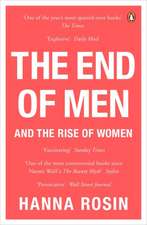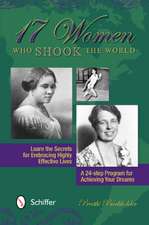Secret Gardens, Satanic Mills – Placing Girls in European History, 1750–1960
Autor Mary Jo Maynes, Birgitte Søland, Christina Benninghaus, Katherine Alaimo, Clare Crowstonen Limba Engleză Paperback – 14 dec 2004
The contributors are Kathleen Alaimo, Christina Benninghaus, Pamela Cox, Clare Crowston, Anna Davin, Andreas Gestrich, Celine Grasser, Irene Hardach-Pinke, Elizabeth Bright Jones, Clair Langhamer, Mary Jo Maynes, Carol E. Morgan, Tammy M. Proctor, Rebecca Rogers, Karin Schmidlechner, Deborah Simonton, Birgitte Soland, and Mary Lynn Stewart."
Preț: 205.87 lei
Nou
Puncte Express: 309
Preț estimativ în valută:
39.40€ • 42.78$ • 33.09£
39.40€ • 42.78$ • 33.09£
Carte tipărită la comandă
Livrare economică 23 aprilie-07 mai
Preluare comenzi: 021 569.72.76
Specificații
ISBN-13: 9780253217103
ISBN-10: 0253217105
Pagini: 328
Ilustrații: 20 b&w illustrations
Dimensiuni: 198 x 234 x 20 mm
Greutate: 0.51 kg
Editura: MH – Indiana University Press
Locul publicării:United States
ISBN-10: 0253217105
Pagini: 328
Ilustrații: 20 b&w illustrations
Dimensiuni: 198 x 234 x 20 mm
Greutate: 0.51 kg
Editura: MH – Indiana University Press
Locul publicării:United States
Cuprins
IntroductionPart I. Working Girls' Labor and Lives in the Pre-industrial and Early Industrial Eras 1. Deborah Simonton: Bringing up Girls: Work in Pre-Industrial Europe 2. Mary Jo Maynes: In Search of Arachne's Daughters: European Girls, Economic Development, and the Textile Trade, 1750-1880 3. Andreas Gestrich: After Dark: Girls' Leisure, Work and Sexuality in Eighteenth- and Nineteenth-century Rural Southwest Germany 4. Clare Crowston: An Industrious Revolution in Late Seventeenth- and Eighteenth-Century Paris: New Vocational Training for Adolescent Girls and the Creation of Female Labor Markets 5. Carol E. Morgan: Work for Girls? The Small Metal Industries in England, 1840-1915. II. Spaces of Socialization of Middle- and Upper-class Girls in the 18th and 19th Centuries 6. Irene Hardach-Pinke: Managing Girls' Sexuality Among the German Upper Classes 7. Rebecca Rogers: Porous Walls and Prying Eyes: Control, Discipline, and Morality in Boarding Schools for Girls in mid-19th century France. 8. Céline Grasser: Good Girls vs. Blooming Maidens: The Building of Female Middle-Class Identities in the Garden, England and France, 1820-1870.III. Redefining Girlhood: Competing Discourses on Female Adolescence, 1880 - 1950 9. Kathleen Alaimo: The Authority of Experts: The Crisis of Female Adolescence in France and England, 1880-1920. 10. Mary Lynn Stewart: Sex Education and Sexual Initiation of Bourgeois French Girls, 1880-1930. 11. Christina Benninghaus: In Their Own Words: Girls' Representations of Growing Up in Germany in the 1920s. 12. Pamela Cox: Girls in Trouble. Defining Female Delinquency, Britain 1900-1950.IV. Changing Patterns of Work and Leisure, 1880-1960 13. Anna Davin: Young Women and Clerical Work in England, 1880-1910. 14. Elizabeth Jones: Girls in Court: Mägde versus their Employers in Saxony, 1880-1914. 15. Tammy Proctor: 'Something for the girls': Organized Leisure in Europe, 1890-1930. 16. Birgitte Søland: Employment and Enjoyment: Female Coming of Age Experiences in Denmark, 1880-1930. 17. Claire Langhamer: Leisure, Pleasure and Courtship: Young Women in England, 1920-1960. 18. Karin M. Schmidlechner: The Emergence of the Modern Teenage Girl in Austria after World War II.
Recenzii
These papers on a wide range of subjects concerning 18th- to 20th-century European young womanhood underscore the distinctive role young girls played in the economic, social, cultural, and political life of their respective countries. The articles prove conclusively that for the overwhelming majority of young European women, work outside the home was a reality. The book's most important feature is the broad overview of the ways in which European societies shaped girls through laws, schools, apprenticeships, sermons, and advice. The articles are divided into four parts. The first examines the experiences of lower-class girls in the working world. The second section discusses middle- and upper-class girls who, though not expected to work outside the home, were relentlessly groomed in order to achieve a proper marriage. The third group of articles illustrates how the increasing importance of scientific study in the late, 19th and early, 20th centuries defined young women by their bodies. The final section shows how work and leisure changed for young women of all classes throughout the late 19th century and into the modern era. An important addition to any discussion of European women. Summing Up: Recommended. All academic levels/libraries.--R. V. A. Gomez, Anne Arundel Community College"Choice" (01/01/2006)
Notă biografică
edited by Mary Jo Maynes, Birgitte Søland, Christina Benninghaus, with contributions by Katherine Alaimo, Clare Crowston, Pamela Cox, Ann Davin, Andreas Gestrich, Céline Grasser, Irene Hardach, Elizabeth Bright Jones, Claire Langhamer, Carol E Morgan, Tammy M Proctor, Rebecca Rogers, Karin M Schmidlechner, Deborah Simonton, Mary Lynn Stewart
Descriere
Essays on the history of girlhood in modern Europe










